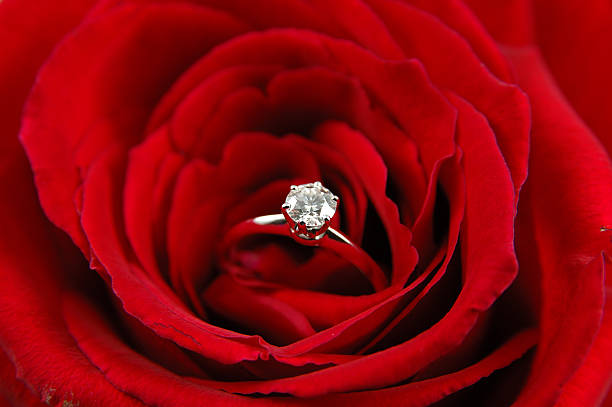
A rose-cut diamond has a flat bottom, no pavilion (the conical underside of a standard diamond), and a domed top with three to 24 facets. Simply put, the rose cut is the top section of a typical round brilliant diamond, and when viewed from above, the facets resemble rose petals, with each pointing outwards towards the stone's edge.
Rose-cut diamonds became popular in the mid-1500s and remained popular until the miner cut and the old European cut emerged in the 18th and 19th centuries.
These diamonds were designed to sparkle by candlelight as an antique cut, and will appeal to anyone who appreciates vintage-inspired romance or a non-traditional aesthetic. Learn about the benefits and drawbacks of this unique cut, as well as what to look for when shopping for a rose-cut ring.
Rose-cut diamonds are unique in that they can be cut into a variety of shapes without the pavilion, making them extremely versatile. This cut comes in a wide range of shapes, from round to oval to kite-shaped to hexagon. This cut also has more "spread," which means that more of the carat weight is facing up, making it appear larger than other cuts when viewed from above. A rose-cut diamond, for example, will frequently appear the same size (in terms of diameter) as a brilliant-cut diamond twice its carat weight. If you want more for your money, the rose-cut is a great alternative to the popular round brilliant diamond cut.
Rose-cut diamonds have a low profile due to their flat shape. A rose-cut diamond will not protrude far from its setting. It's a simple diamond to wear, especially for people who are very active.
However, because rose-cut diamonds lack a pavilion, their light return (the amount of light reflected throughout the diamond) is significantly lower than that of a modern diamond. This style is more low-key and subtle, and it may not be suitable for the bride who prefers sparkle and drama.
When shopping for diamond jewelry, pay close attention to the GIA or AGS certificate. However, when it comes to antique diamond cuts, personal preference is often more important. Focus on purchasing a diamond that appeals to your eye, as the GIA grading process may not take into account features that you appreciate in the rose cut. They have a distinct natural beauty that cannot be adequately captured in a report. It's a diamond that you have to see in person.
When shopping for these diamonds, color should not be the primary consideration, as many antique cut diamonds with excellent color have been recut into modern diamonds. As a result, colorless or near-colorless rose-cut diamonds are extremely rare.
Rather than color, concentrate on clarity. Rose-cut diamonds are more transparent than other cuts, making them more susceptible to flaws and imperfections. Check for inclusions and other internal characteristics when comparing rose-cut diamonds.
In terms of settings, a vintage setting is an ideal complement to such an illustrious diamond. Rose-cut diamonds, as an antique diamond cut, look best in period settings. Consider an Edwardian or Victorian setting to really showcase these beauties, or go for a modern twist with a sleek bezel that also serves as more convenience and protection.
Rose cuts are more susceptible to chipping than traditional round brilliant diamonds because they are shallower. Diamonds are famous for their durability, but they can be chipped by a sharp blow, become loose in a weakened setting, or be damaged by contact with other diamonds. Dedrickson recommends a more protective setting, such as a halo or bezel.
Wear with caution when wearing diamonds. To avoid scratches, keep it separate from other diamond jewelry. Wipe your engagement ring clean with a lint-free cloth, warm water, mild soap, and a soft toothbrush, or a quick dip in a commercial cleaning solution. Last but not least, have your ring cleaned and its setting examined by a professional jeweler on a regular basis to ensure its longevity.
Sell your diamonds with ease with Diamond Registry’s comprehensive approach and vast global industry connections to help you find the best buyer for your diamond fast. Visit www.diamondregistry.com/sell-your-ring to take your first step to fast, easy and reliable way of selling your diamond.
Want to check and calculate diamond per carat instantly? Go to DR’s diamond price calculator to know how. Reliable and trusted carat calculator in the diamond industry since!

